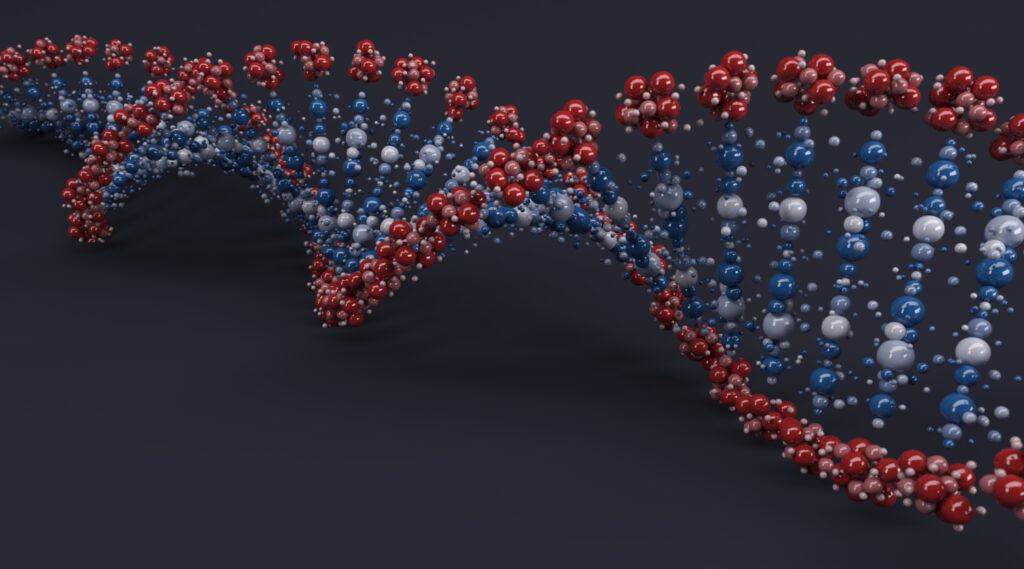Table of Contents
ToggleGenomic Analysis Software: A Comprehensive Guide for Healthcare Facilities and Patients
Imagine a spell-checker, but for DNA: compared to displaying a misspelt word, it detects genetic alterations that may elucidate an illness for clinicians and researchers to review [1]. This is one of the most critical biomedical solutions currently accessible to hospitals and laboratories [2].
Genomic medicine has accelerated the early diagnosis techniques used in labs, hospitals or by physicians through the use of high-throughput genetic approaches [3]. Sequencing tools provide the raw DNA sequences, but they cannot offer guidance on how to treat a medical condition on their own [4]. To address this discrepancy, an increasing number of healthcare providers are utilising genomic analysis software —a digital tool that converts sequencing data into actionable medical information [5].
Softwares like these converts billions of letters of human DNA into a readable report to medical professionals, genetic counselors, before being presented to patients [6].
What is Genomic Analysis Software?
Genomic analysis software is a bioinformatics application that converts raw sequence information into structured data for clinicians to select to report [7].
With just 3mL of patient’s blood:
- laboratories perform sequencing experiments,
- transmit the data to the platform,
- the software’s algorithms identify genetic variations [8].
Most importantly, data are further referenced against scientific literature, medical databases, population models/scores to determine their clinical relevance [9].
Integration of genomic medicine directly into the national healthcare system is the trend in medicine [10]. Gene analysis systems, like InheriNext, make it easier to sift and rank genomic data and facilitate clinical decision support systems (CDSS). [11]; helping clinicians acquire these records to inform their decisions in the likes of oncology clinics, neonatal critical care units, or genetic counselling offices [12].
What does Genomic Data Analysis Mean In Modern Medicine?
Inherited rare diseases and cancer, and the genetic data or genetic information behind them, helps clinicians and researchers find the cause behind patient symptoms before making accurate diagnoses or suggest treatments.
In this case, “good” genomic software refers to software that helps doctors provide comprehensive care to their patients.
- Automation and accuracy, which cut down on mistakes caused by manual handling/discrepancies
- Transparency; integrated data sources making clear why a result is important.
- Synced with medical databases to always fetch the latest findings.
- Following internationally accepted clinical standards (such as ACMG guideline) and strong norms for data privacy.
Where It Helps Most: Primary Beneficiaries
Diagnosing rare diseases: In newborn intensive care units (NICUs), unidentified metabolic or neurological disorders might pose a substantial risk to life. Rapid genetic testing is important for conditions as mitochondrial abnormalities or congenital syndromes to allow for early medical treatment. Using NGS analysis software to analyze data more quickly could cut the time it takes to make a diagnosis from months to just a few days [13]; where every second is crucial.
Applications in oncology: Targeted therapy for cancer usually relies on mutations found in the DNA of cancer cells. Tumour sequencing combined with bioinformatics may reveal pertinent mutations, facilitating precision medicine. Gene analysis software can link mutations to specific drugs or determine who is eligible to participate in clinical trials [14].
Improved efficiency: Labs benefit from automation and regularity. Automated solutions cut down on the time spent on repetitive interpretation tasks and make sure that documentation is always clear and correct. Instead of going through each case by hand, personnel can shift away from manual labour, and utilize bioinformatic services or softwares to to improve efficiency with standardized, consistent analyses of high standards [15].
Even with automation, doctors and geneticists are responsible for reviewing the clinical relevance and ethical presentation of results [16].

How Genomic Analysis Software Works?
- Submit sequencing files – raw DNA data (either VCF or FASTQ) is securely uploaded from medical laboratories or research institutes.
- Variant calling – the computational biology software algorithm performs quality check, and identifies known genetics changes
- Clinical evaluation – the platform ranks variant findings with numerous scoring metrics, and presents references against medical databases (such as ClinVar or OMIM), inheritance models, population statistics, ACMG guidelines, or other hereditary risk factors.
- Report summary – selecting the causative variant of interest, the physician gets a concise, clinically focused report
Note: results are to be evaluated by medical professionals only. The system functions as an assistance, not a replacement. Additionally, data insights software is to value data privacy highly, considering the sensitive nature of genomic records [17].
How To Choose Suitable Genomic Analysis Software
When medical facilities and research labs are looking for bioinformatic services or software, a good software platform should meet the following criteria:
Speed: Prompt analytical turn-around-time (TAT) enables quick clinical response
Clarity/Transparency: Ranked result and reports must give clear and referenced reasons which show why the result is important.
Data Privacy: The most essential thing to segregate patient records per recognized privacy rules (such as GDPR or HIPAA) or internal hospital instructions.
Budget friendly: Cost-effective and scalable pricing options for all.
Future-proofing: The best systems enable looking at old cases again when new information comes, and making sure that the results stay up to date (re-analysis).
Fundamental Characteristics of Modern Genomic Analysis Software
- Automation: Removes human error and improves consistency and reproducibility for robust results
- Compliance: Follows international guideliens such as ACMG for variant analyses, or GDPR, HIPAA, APPI etc for data privacy..
- Connectivity: The ability to connect to curated medical databases and various population models.
- Visualization: User-friendly, easy-to-use intuitive designs easy to pick-up and use!
- Platform-agnostic: Recognized universal input file types (VCF or FASTQ) or ontology terms (such as HPO). Webpage access. No downloads, no headaches.
- Benchmarked Performance: Benchmarked against competitors using global datasets (such as GA4PH Phenopacket stores).
The Applications and Utilizations of Genomic Software in Hospitals and Laboratory Facilities
Genetic analysis: Identifying individuals or carriers of inherited or rare diseases such as cystic fibrosis, muscular dystrophy
Oncology utilization: Identifying actionable genes alterations such as EGFR, ERBB2(HER2), or BRCA1/2 variants associated with cancer risk and therapy selection.
Prenatal and neonatal testing: Proactive testing for chromosomal or monogenic diseases prior to the manifestation of symptoms.
Population genomics: Charting variation in genes for cohort research or preventive healthcare programs.
Pharmacogenomics: Obtain candidate data for subsequent research into genetic differences on medication metabolism.
These use cases highlight that the most effective genomics analysis software delivers not just efficiency, but also reliability, long-term value, and contributes to d better patient outcomes.
Subsequent Enhancement of Patient Care That Can Follow Genomic Analysis
Patients benefit from rapid responses in emergency circumstances;
- Personalized treatment recommendations
- Excellence in complicated genetic analysis
Hospitals gain via a reduced workload for staff;
- Reporting which is standardized and compatible with the rules and regulations.
- Integration with extensive biomedical solutions inside healthcare IT systems.
Ultimately, genomic analysis software paves the way for a seamless integration of biological data in precision medicine, and helps advance patient outcomes and streamlining hospital operations. [18].
New Trends in Genomic Analysis
AI-driven interpretation: Apply Machine Learning (ML) to optimize variant ranking.
Cloud collaboration: Safe and secure data-sharing across borders.
Automated re-evaluation: Screens for database updates to perform old case re-analyses as scientific knowledge advances.
Getting users involved: Improving platforms via user feedbacks that let users safely see and understand their results.
Global standards: regulatory standards are gradually being established worldwide to guide genetic reporting..
Finally, Choosing the Right Software for Genomic Analysis
Genetic analysis systems, which set the foundation of precision medicine, are becoming increasingly significant in hospitals and labs.. When choosing genetic software, you need to think about how well it works in the real world, whether it follows the industry standards, how easy it is to scale it in terms of data input and costs [19].
The need for gene analysis software, bioinformatics tools, and data analytics software will keep growing as sequencing methods improve and become increasingly accessible. The most important thing is that you choose solutions such as that are trustworthy, protect patient data, and work with hospital systems [20].
| Want to see it in action? InheriNext®’s benchmarked results show 98.6% sensitivity, with transparent, trustworthy variant ranking you can rely on.
In healthcare, selecting the right solution isn’t just a product choice — it’s backing breakthroughs that convert DNA into life-saving therapies. And when you’re paired with the right genomic analysis software, you can unlock capabilities beyond the usual limits!
REFERENCES
- Clark, A. J., & Lillard, J. W., Jr. (2024). A Comprehensive Review of Bioinformatics Tools for Genomic Biomarker Discovery Driving Precision Oncology. Genes, 15(8), 1036.
- Dunlop, K. L. A., Murray, E., & Johnston, L. (2025). Building capacity for genomics in primary care: A scoping review. Frontiers in Medicine, 12, Article 1577958.
- Ahn, J. H., Lee, S. Y., Kim, H. M., & Park, J. H. (2024). Implementing genomic medicine in clinical practice for undiagnosed diseases. NPJ Genomic Medicine, 9(1), 11.
- Riess, O., & Klein, C. (2024). Genomes in clinical care: Transforming how we diagnose and treat diseases. NPJ Genomic Medicine, 9(1), 13.
- Bagger, F. O., Jensen, T. H., & Hansen, M. S. (2024). Whole genome sequencing in clinical practice: Applications, challenges, and clinical reporting. BMC Medical Genomics, 17, Article 56.
- Méndez-Vidal, C., Bravo-Gil, N., Pérez-Florido, J. et al. A genomic strategy for precision medicine in rare diseases: integrating customized algorithms into clinical practice. J Transl Med 23, 86 (2025). https://doi.org/10.1186/s12967-025-06069-2
- Mendez, K. M., Reinke, S. N., Kelly, R. S., Chen, Q., Su, M., McGeachie, M., Weiss, S., Broadhurst, D. I., & Lasky-Su, J. A. (2025). A roadmap to precision medicine through post‑genomic electronic medical records. Nature Communications, 16(1), Article 1700.
- Gupta, A., Kumar, S., & Kumar, A. (2024). Big data in bioinformatics and computational biology: Basic insights. In A. Gupta, S. Kumar, & A. Kumar (Eds.), Methods in Molecular Biology (Vol. 2719, pp. 153–166). Humana.
- Savatt, J. M., Kelly, M. A., Sturm, A. C., McCormick, C. Z., Williams, M. S., Nixon, M. P., Rolston, D. D., Strande, N. T., Wain, K. E., Willard, H. F., Faucett, W. A., Ledbetter, D. H., Buchanan, A. H., & Martin, C. L. (2025). Genomic Screening at a Single Health System. JAMA network open, 8(3), e250917.
- Abadie, C., Lemoine, A., Dupuis, F., & Gauchez, A. S. (2025). PFMG2025: Integrating genomic medicine into the national healthcare system in France. The Lancet Regional Health – Europe, 50, Article 101183.
- Mani, S., Nguyen, M. Q., & Patel, A. (2025). Genomics and multiomics in the age of precision medicine. Nature Reviews Pediatrics, 2(3), 133–145.
- Ali, S.S., Li, Q. & Agrawal, P.B. Implementation of multi-omics in diagnosis of pediatric rare diseases. Pediatr Res 97, 1337–1344 (2025). https://doi.org/10.1038/s41390-024-03728-w
- Arbitrio M, Milano M, Lucibello M, Altomare E, Staropoli N, Tassone P, Tagliaferri P, Cannataro M, Agapito G. Bioinformatic challenges for pharmacogenomic study: tools for genomic data analysis. Front Pharmacol. 2025 Apr 11;16:1548991.
- Nappi, F. (2024). In‑Depth Genomic Analysis: The New Challenge in Congenital Heart Disease. International Journal of Molecular Sciences, 25(3), 1734.
- Jiang X, Tse K, Wang S, Doan S, Kim H, Ohno-Machado L. Recent trends in biomedical informatics: a study based on JAMIA articles. J Am Med Inform Assoc. 2013 Dec;20(e2):e198-205. doi: 10.1136/amiajnl-2013-002429. Epub 2013 Nov 8. PMID: 24214018; PMCID: PMC3861936.
- Yang, C., Wang, X., & Liu, T. (2025). An inclusive foundation model for generalizable cytogenetics in precision oncology (CHROMA). arXiv Preprint. https://arxiv.org/abs/2505.15868
- Papangelou, C., Tsiamis, G., & Kapellos, T. S. (2025). Reliable machine learning models in genomic medicine: Conformal prediction for clinical applications. Frontiers in Bioinformatics, 5, Article 1507448.
- Krummenacher, R., Borner, T., & Keller, M. (2025). Scalable genomic context analysis with GCsnap2 on HPC clusters. arXiv Preprint. https://arxiv.org/abs/2505.02195
- Ismail, F. N., & Amarasoma, S. (2025). An integrated genomics workflow tool: Optimizing variant calling algorithms. arXiv Preprint. https://arxiv.org/abs/2504.17860
- Bisoi, A. V., & Ramsundar, B. (2024). A modular open source framework for genomic variant calling. arXiv Preprint. https://arxiv.org/abs/2411.11513


